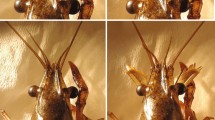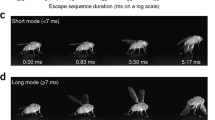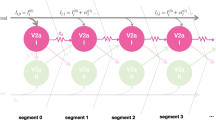Abstract
Cockroaches (Periplaneta americana) respond to air displacement produced by an approaching predator by turning and running away. A set of 4 bilateral pairs of ventral giant interneurons is important in determining turn direction. Wind from a given side is known to produce more spikes, an earlier onset of the spike trains, and different fine temporal patterning, in the ipsilateral vs the contralateral set of these interneurons. Here we investigate which of these spike train parameters the cockroach actually uses to determine the direction it will turn.
We delivered controlled wind puffs from the right front, together with intracellular injection of spike trains in a left ventral giant interneuron, under conditions where the animal could make normally directed turning movements of the legs and body. In trials where our stimuli caused the left side to give both the first spike and more total spikes than the right, but where our injected spike train included none of the normal fine temporal patterning, 92% of the evoked turns were to the rightopposite of normal (Figs. 4–6). In trials where the left side gave the first spike, but the right side gave more spikes, 100% of the turns were to the left-the normal direction (Figs. 8, 9). Comparable results were obtained when each of the left giant interneurons 1, 2 or 3 were electrically stimulated, and when either weak or stronger wind puffs were used. Stimulating a left giant interneuron electrically in the absence of a wind puff evoked an escape-like turn on 9% of the trials, and these were all to the right (Fig. 9).
These results indicate that fine temporal patterning in the spike trains is not necessary, and information about which side gives the first spike is not sufficient, to determine turn direction. Rather, the key parameter appears to be relative numbers of action potentials in the left vs the right group of cells. These conclusions were supported by similar experiments in which extracellular stimulation of several left giant interneurons was paired with right wind (Figs. 11, 12).
Similar content being viewed by others
Abbreviations
- GI:
-
giant interneuron
- vGI:
-
ventral giant interneuron
- dGI:
-
dorsal giant interneuron
- LY:
-
Lucifer yellow
- CF:
-
carboxyfluorescein
References
Abeles M (1988) Neural codes for higher brain functions. In: Markivitsch H (ed) Information processing by the brain: a physiological-cognitive perspective. Hans Huber Press, Bern, pp 223–232
Atkins GS, Ligman F, Burghardt T, Stout FJ (1984) Changes in phonotaxis by the female cricket Acheta domesticus L. after killing identified acoustic interneurons. J Comp Physiol A 154:795–804
Blagburn JM, Beadle DJ, Sattelle DB (1984) Synapses between an identified giant interneurone and a filiform hair sensory neurone in the terminal ganglion of first instar cockroaches, Periplaneta americana. J Exp Biol 113:477–484
Britten KH, Shalden MN, Newsome WT, Movshon JA (1992) The analysis of visual motion: A comparison of neuronal and psychophysical performance. J Neurosci 12:4745–4765
Burdohan JA, Comer CM (1990) An antennal-derived mechanosensory pathway in the cockroach: Descending interneurons as a substrate for evasive behavior. Brain Res 535:347–352
Callec JJ, Satelle DB (1973) A simple technique for monitoring the synaptic action of pharmacological agents. J Exp Biol 59:725–738
Camhi, J (1980) The escape system of the cockroach. Sci Am 243(6): 158–172
Camhi JM, Levy A (1988) Organization of a complex movement: Fixed and variable components of the cockroach escape behavior. J Comp Physiol A 163:317–328
Camhi JM, Levy A (1989) The code for stimulus direction in a cell assembly in the cockroach. J Comp Physiol A 165:83–97
Camhi JM, Nolen TG (1981) Properties of the escape system of cockroaches during walking. J Comp Physiol 142:339–346
Camhi JM, Tom W (1978) The escape system of the cockroach Periplaneta americana: I. The turning response to wind puffs. J Comp Physiol 128:193–201
Camhi JM, Tom W, Volman S (1978) The escape behavior of the cockroach Periplaneta americana: II. Detection of natural predators by air displacement. J Comp Physiol 128:203–212
Comer CM (1985) Analyzing cockroach escape behavior with lesions of individual giant interneurons. Brain Res 335:342–346
Comer CM, Dowd JP (1987) Escape turning behavior in the cockroach: Changes in directionality induced by unilateral lesions of the abdominal nervous system. J Comp Physiol A 160:571–583
Comer CM, Dowd JP (1993) Multisensory processing for movement: Antennal and cereal mediation of escape turning in the cockroach. In: Beer RD, Ritzmann RE, McKenna T (eds). Biological neural networks in invertebrate neuroethology and robotics. New York, Academic Press, pp 89–112
Dagan D, Camhi JM (1979) Responses to wind recorded from the cereal nerve of the cockroach Periplaneta americana: II. Directional selectivity of the sensory nerves innervating single columns of filiform hairs. J Comp Physiol 133: 103–110
Daley DL, Vardi N, Appignani B, Camhi JM (1981) Morphology of the giant interneurons and cereal nerve projections of the American cockroach. J Comp Neurol 196:41–52
Dowd JP, Comer C (1988) The neural basis of orienting behavior: A computational approach to the escape turn of the cockroach. Biol Cybern 60:37–48
Georgopoulos AP, Taira M, Lukashin A (1993) Cognitive neurophysiology of the motor cortex. Science 260:42–52
Glimcher PW, Sparks DL (1992) Movement selection in advance of action in the superior colliculus. Nature 355:142–145
Hamon A, Guillet JC, Callec JJ (1990) A gradient of synaptic efficacy and its presynaptic basis in the cereal system of the cockroach J Comp Physiol A 167:363–376
Hubel DH, Wiesel TN (1968) Receptive fields and functional architecture of monkey striate cortex. J Physiol (Lond) 195:215–243
Kolton L, Camhi JM (1973) Re-evaluating the directional sensitivity of identified giant interneurons of the cockroach. Soc Neurosci Abstr 19:702
Konishi M (1986) Centrally synthesized maps of sensory space. Trends Neurosci 9:163–168
Konishi M (1993) Neuroethology of sound localization in the owl. King Solomon Lectures in Neuroethology. J Comp Physiol A 173:3–7
Libersat F, Levy A, Camhi JM (1989) Multiple feedback loop in the flying cockroach: Excitation of the dorsal and inhibition of the ventral giant interneurons. J Comp Physiol A 165:651–668
Metzner W (1993) The jamming avoidance response in Eigenmanniais controlled by two separate motor pathways. J Neurosci 13:1862–1878
Miller JP, Jacobs GA, Theunissen FE (1991) Representation of sensory information in cricket cereal sensory systems I. Response properties of the primary interneurons. J Neurophysiol 66:1680–1703
Moiseff A, Konishi M (1981) Neural and behavioral sensitivity to binaural time differences in the owl. J Neurosci 1:40–48
Mörchen A, Rheinlaender J, Schwarzkopff J (1978) Latency shift in insect auditory nerve fibers. Naturwissenschaften 65:656–657
Nicklaus R (1965) Die Erregung einzelner Fadenhaare von Periplaneta americana in Abhängigkeit von der Grösse und Richtung der Auslenkung. Z Vergl Physiol 50:331–362
Nye SW, Ritzmann RE (1992) Motion analysis of leg joints associated with escape turns of the cockroach Periplaneta americana. J Comp Physiol A 171:183–194
Optican LM, Richmond BJ (1992) Temporal encoding of two-dimensional patterns by single units in primary inferior temporal cortex III. Information theoretic analysis. J Neurophysiol 57:162–178
Rheinlaender J, Mörchen A (1979) Time-intensity trading in locust auditory interneurones. Nature 281:672–674
Riquimaroux H, Gaioni SJ, Suga N (1992) Inactivation of the DSCF area of the auditory cortex disrupts frequency discrimination in the mustached bat. J Neurophysiol 68:1613–1623
Ritzmann RE (1981) Motor responses to paired stimulation of giant interneurons in the cockroach Periplaneta americana: II. The ventral giant interneurons. J Comp Physiol 143:71–80
Ritzmann RE (1993) The neural organization of cockroach escape and its role in context-dependent orientation. In: Beer RD, Ritzmann RE, McKenna T (eds). Biological neural networks in invertebrate neuroethology and robotics. New York, Academic Press, pp 113–137
Ritzmann RE, Camhi JM (1978) Excitation of leg motor neurons by giant interneurons in the cockroach Periplaneta americana. J Comp Physiol 125:305–316
Ritzmann RE, Pollack AJ (1986) Identification of thoracic interneurons that mediate giant interneuron-to-motor pathways in the cockroach. J Comp Physiol A 159:639–654
Ritzmann RE, Pollack AJ (1988) Wind-activated thoracic interneurons of the cockroach: II. Patterns of connection from ventral giant interneurons. J Neurobiol 19:589–594
Salzman CD, Britten KH, Newsome WT (1990) Cortical microstimulation influences perceptual judgements of motion direction. Nature 346:174–177
Theunissen FE, Miller JP (1991) Representations of sensory information in the cricket cereal sensory system II. Information theoretic calculation of system accuracy and optimal tuning-curve widths of four primary interneurons. J Neurophysiol 66:1690–1702
Westin J (1979) Responses to wind recorded from the cereal nerve of the cockroach, Periplaneta americana. I. Response properties of single sensory neurons. J Comp Physiol 133:97–102
Westin J, Langberg JJ, Camhi JM (1977) Responses of the giant interneurons of the cockroach Periplaneta americana to wind puffs of different directions and velocities. J Comp Physiol 121:307–324
Author information
Authors and Affiliations
Rights and permissions
About this article
Cite this article
Liebenthal, E., Uhlmann, O. & Camhi, J.M. Critical parameters of the spike trains in a cell assembly: coding of turn direction by the giant interneurons of the cockroach. J Comp Physiol A 174, 281–296 (1994). https://doi.org/10.1007/BF00240211
Accepted:
Issue Date:
DOI: https://doi.org/10.1007/BF00240211




